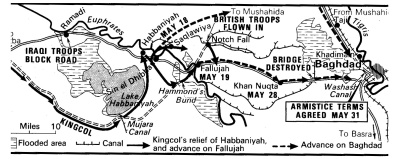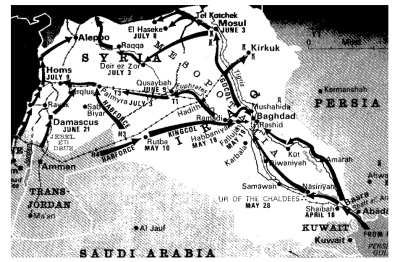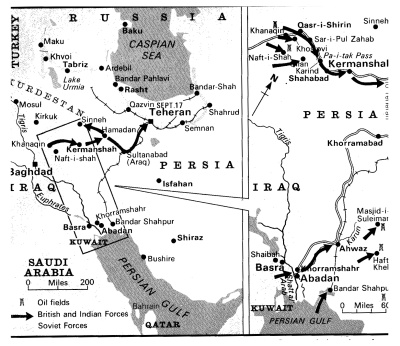WHEN BRITAIN LAST INVADED IRAQ: IRAQI CRISIS APRIL-JUNE 1941
Tuesday, 11 March 2003
By Correspondent

The British have fought in Iraq before. During World War 2 a pro-Axis coup in Baghdad led the British to invade. The tactics of invasion and what happened to the region are discussed in this article. Iraq was a territory created after the dismemberment of the Ottoman Empire at the end of WW I. It was a British Mandated Territory ruled by King Faisal ibn Hussain (a relative of Saddam?) from 1920-1930. After this it became an independent state except for two British airbases maintained at Shaibah near Basra, and Habbaniyah 55 miles west of Baghdad. The British-Iraqi treaty that enabled these bases also required Iraq to offer all aid possible to Britain in time of war. However by 1939 there was general antipathy to Britain, mainly due to the growth of Arab nationalism.
In April 1 1941 Raschid Ali led a group of Iraqi generals known as the ‘Golden Square’ to power in Iraq by coup. This new regime was pro-German (it is said Ali was in the pay of Berlin) and immediately caused concern for London. At this time Britain was alone and in desperate straits in it’s battle against Hitler. Then, as now, Iraq was an area of vital importance; it was near the essential supply routes to India and South East Asia, and its oil would be a godsend to Hitler and his army. To force the issue of whether the new regime would comply with the Britain-Iraq treaty the British decided to let Ali know that they wanted to transport some troops through Iraq to Palestine (another territory that has ‘benefited’ from British rule!). On April 16 Ali agreed to this demand. The troops, an Indian Division, landed at Basra.
After this force landed Ali announced that “no further British troops should be disembarked until the force already landed has passed through and at no time should British forces exceed one division”. But the British wanted more troops to arrive; and when they did Ali decided to attack even though he knew that no immediate German aid was available. On April 29 the British base at Habbaniyah was surrounded and the British controlled Iraqi Petroleum Company oilfields at Kirkuk were occupied. This last step cut the flow of oil to the British Middle East armies and now made them available to the Axis forces.
And so began the battle for Iraq 1941. The British forces at Habbaniyah hit back against the surrounding Iraqi troops. Included in their number were Kurdish and Assyrian (Marsh Arabs?) troops who were more than happy to fight against the Arab enemy. In Basra as more Indian troops arrived fighting also flared. In May German aid in the form of Luftwaffe support began to arrive in Iraq, but the German commander of this force Major von Blomberg was killed by Iraqi soldiers who mistakenly fired on his aircraft! To help the Habbaniyah garrison General Wavell (C-in-C of British Middle East forces) organised relieving forces to move into Iraq from Jordan. This group known as ‘Habforce’ included 350 men of the Arab Legion. Commanded by Glubb Pasha they were known as Glubb’s Girls because of their ‘flowing robes, long hair, and gay headscarves’. They reached Habbaniyah by May 18 and then began their march on Baghdad. It is interesting to note that this attack on Baghdad was all done at the height of the Iraqi summer with temperatures reaching 49C! It should be a doddle for the military geniuses of today.

With Baghdad surrounded by the British forces, and his own armies morale crushed, Raschid Ali decided to flee Baghdad for Persia. The remaining members of his regime decided to sue for peace and major hostilities finished on May 31. However, because of the unpopularity of the British with most of the Iraqi population garrison forces had to remain in Iraq until the end of the war; in particular guarding the vital oilfields at Mosul and Kirkuk.

The occupation of Iraq opened up new possibilities for the British in the Middle East. In June they were able to advance on Vichy French held Syria and Lebanon. And once the German invasion of Russia began, the British were able to invade and occupy Persia (now Iran) in a joint operation with Soviets.

There are some interesting correlation’s of this campaign with the soon to be Iraqi war 2003. A military strongman in Baghdad was the enemy. Oil was again a crucial element in why action had to be taken. And like today, the British forces used leaflet drops and infiltrated Iraqi army communications to send propaganda messages to deflate Iraqi Army morale. Tactically though today’s invasion would be different; no forces would be allowed to advance from Jordan, and with the role of Turkey still unclear, it would appear that the main thrust on Baghdad would be made up the Tigris and Euphrates rivers. The British forces that attacked from this route in 1941 certainly had more trouble than those that had come across the desert from Jordan, and were stopped from reaching Baghdad before Iraqi forces capitulated on May 31.
Perhaps the most important lesson to be drawn from this campaign is what happened once Iraq was conquered. The important strategic location of Iraq enabled the rapid subjugation of neighbouring countries in the Middle East. With a likely occupying force of over 200 000, the United States will be in an overwhelming position to threaten other “rogue” states of the region. For Tehran and Damascus the lessons from 1941 are a frightful warning of what could happen in 2003.





